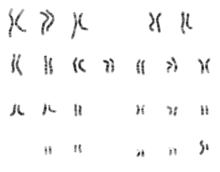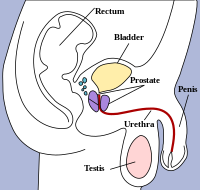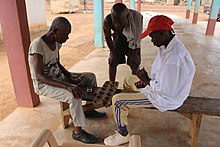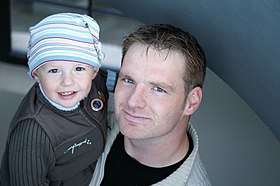Man
This is Wikipedia's current article for improvement – and you can help edit it! You can discuss how to improve it on its talk page and ask questions at the help desk or Teahouse. See the cheatsheet, tutorial, editing help and FAQ for additional information. Editors are encouraged to create a Wikipedia account and place this article on their watchlist.
Find sources: "Man" – news · newspapers · books · scholar · JSTOR |

A man (pl.: men) is an adult male human.[1][2] Prior to adulthood, a male human is referred to as a boy (a male child or adolescent).
Like most other male mammals, a man's genome usually inherits an X chromosome from the mother and a Y chromosome from the father. Sex differentiation of the male fetus is governed by the SRY gene on the Y chromosome. During puberty, hormones which stimulate androgen production result in the development of secondary sexual characteristics, thus exhibiting greater differences between the sexes. These include greater muscle mass, the growth of facial hair and a lower body fat composition. Male anatomy is distinguished from female anatomy by the male reproductive system, which includes the penis, testicles, sperm duct, prostate gland and the epididymis, and by secondary sex characteristics, including a narrower pelvis, narrower hips, and smaller breasts.
Throughout human history, traditional gender roles have often defined and limited men's activities and opportunities. Men often face conscription into military service or are directed into professions with high mortality rates. Many religious doctrines stipulate certain rules for men, such as religious circumcision. Men are over-represented as both perpetrators and victims of violence.
Trans men have a gender identity that does not align with their female sex assignment at birth, while intersex men may have sex characteristics that do not fit typical notions of male biology.
Etymology
The English term "man" is derived from the Proto-Indo-European root *man- (see Sanskrit/Avestan manu-, Slavic mǫž "man, male").[3] More directly, the word derives from Old English mann. The Old English form primarily meant "person" or "human being" and referred to men, women, and children alike. The Old English word for "man" as distinct from "woman" or "child" was wer. Mann only came to mean "man" in Middle English, replacing wer, which survives today only in the compounds "werewolf" (from Old English werwulf, literally "man-wolf"), and "wergild", literally "man-payment".[4][5][6]
Biology

In humans, sperm cells carry either an X or a Y sex chromosome. If a sperm cell carrying a Y chromosome fertilizes the female ovum, the offspring will have a male karyotype (XY). The SRY gene is typically found on the Y chromosome and causes the development of the testes, which in turn govern other aspects of male sex differentiation. Sex differentiation in males proceeds in a testes-dependent way while female differentiation is not gonad dependent.[7]
Primary sex characteristics (or sex organs) are characteristics that are present at birth and are integral to the reproductive process. For men, primary sex characteristics include the penis and testicles.
Adult humans exhibit sexual dimorphism in many other characteristics, many of which have no direct link to reproductive ability. Humans are sexually dimorphic in body size, body structure, and body composition. Men tend to be taller and heavier than women, and adjusted for height, men tend to have greater lean and bone mass than women, and lower fat mass.[8]

Secondary sex characteristics are features that appear during puberty in humans.[9][10] Such features are especially evident in the sexually dimorphic phenotypic traits that distinguish between the sexes, but—unlike the primary sex characteristics—are not directly part of the reproductive system.[11][12][13] Secondary sexual characteristics that are specific to men include:
- Broadened shoulders;[14]
- Increased body hair;
- An enlarged larynx (also known as an Adam's apple);[14] and
- A voice that is significantly deeper than the voice of a child or a woman.[12]
Men weigh more than women.[15] On average, men are taller than women by about 10%.[15] On average, men have a larger waist in comparison to their hips (see waist–hip ratio) than women. In women, the index and ring fingers tend to be either more similar in size or their index finger is slightly longer than their ring finger, whereas men's ring finger tends to be longer.[16]
Reproductive system

The male reproductive system includes external and internal genitalia. The male external genitalia consist of the penis, the male urethra, and the scrotum, while the male internal genitalia consist of the testes, the prostate, the epididymis, the seminal vesicle, the vas deferens, the ejaculatory duct, and the bulbourethral gland.[17]
The male reproductive system's function is to produce semen, which carries sperm and thus genetic information that can unite with an egg within a woman. Since sperm that enters a woman's uterus and then fallopian tubes goes on to fertilize an egg which develops into a fetus or child, the male reproductive system plays no necessary role during the gestation. The study of male reproduction and associated organs is called andrology.[18]
Testosterone stimulates the development of the Wolffian ducts, the penis, and closure of the labioscrotal folds into the scrotum. Another significant hormone in sexual differentiation is the anti-Müllerian hormone, which inhibits the development of the Müllerian ducts. For males during puberty, testosterone, along with gonadotropins released by the pituitary gland, stimulates spermatogenesis.[19]
Health
While a majority of the global health gender disparities is weighted against women, there are situations in which men tend to fare poorer. One such instance is armed conflicts, where men are often the immediate victims. A study of conflicts in 13 countries from 1955 to 2002 found that 81% of all violent war deaths were male.[20] Apart from armed conflicts, areas with high incidence of violence, such as regions controlled by drug cartels, also see men experiencing higher mortality rates.[21] This stems from social beliefs that associate ideals of masculinity with aggressive, confrontational behavior.[22] Lastly, sudden and drastic changes in economic environments and the loss of social safety nets, in particular social subsidies and food stamps, have also been linked to higher levels of alcohol consumption and psychological stress among men, leading to a spike in male mortality rates. This is because such situations often makes it harder for men to provide for their family, a task that has been long regarded as the "essence of masculinity."[23] A retrospective analyses of people infected with the common cold found that doctors underrate the symptoms of men, and are more willing to attribute symptoms and illness to women than men.[24] Women live longer than men in all countries, and across all age groups, for which reliable records exist.[25] In the United States, men are less healthy than women across all social classes. Non-white men are especially unhealthy. Men are over-represented in dangerous occupations and represent a majority of on the job deaths. Further, medical doctors provide men with less service, less advice, and spend less time with men than they do with women per medical encounter.[26]
Sexuality and gender
Male sexuality and attraction are variable, and a man's sexual behavior can be affected by many factors, including evolved predispositions, personality, upbringing, and culture. While the majority of men are heterosexual, significant minorities are homosexual or bisexual.[27]
Most cultures use a gender binary in which man is one of the two genders, the other being woman.[28][29][30]
Trans men have a male gender identity that does not align with their female sex assignment at birth and may undergo masculinizing hormone replacement therapy and/or sex reassignment surgery,[31] while intersex men may have sex characteristics that do not fit typical notions of male biology.[32] A 2016 systemic review estimated that 0.256% of people self-identify as female-to-male transgender.[33] A 2017 survey of 80,929 Minnesota students found that roughly twice as many female-assigned adolescents self-identified as transgender, compared to adolescents with a male sex assignment.[34]
Social role
Masculinity

Masculinity (also sometimes called manhood or manliness) is the set of personality traits and attributes associated with boys and men. Although masculinity is socially constructed,[35] some research indicates that some behaviors considered masculine are biologically influenced.[36] To what extent masculinity is biologically or socially influenced is subject to debate.[36] It is distinct from the definition of the biological male sex, as both males and females can exhibit masculine traits.[37] Men generally face social stigma for embodying feminine traits, more so than women do for embodying masculine traits.[38] This can also manifest as homophobia.[39]
Standards of manliness or masculinity vary across different cultures and historical periods.[40] While the outward signs of masculinity look different in different cultures, there are some common aspects to its definition across cultures. In all cultures in the past, and still among traditional and non-Western cultures, getting married is the most common and definitive distinction between boyhood and manhood.[41] In the late 20th century, some qualities traditionally associated with marriage (such as the "triple Ps" of protecting, providing, and procreating) were still considered signs of having achieved manhood.[41][42]
Relationships

Platonic relationships are not significantly different between men and women, though some differences do exist. Friendships involving men tend to be based more on shared activities than self-disclosure and personal connection. Perceptions of friendship involving men varies among cultures and time periods.[43] In heterosexual romantic relationships, men are typically expected to take a proactive role, initiate the relationship, plan dates, and propose marriage.[44]
Status
Anthropology has shown that masculinity itself has social status, just like wealth, race and social class. In Western culture, for example, greater masculinity usually brings greater social status.[45] Many English words such as virtue and virile (from the Indo-European root vir meaning man) reflect this.[46][47] In most cultures, male privilege allows men more rights and privileges than women. In societies where men are not given special legal privileges, they typically hold more positions of power, and men are seen as being taken more seriously in society.[45] This is associated with a "gender-role strain" in which men face increased societal pressure to conform to gender roles.[48]
History
The earliest known recorded name of a man in writing is potentially Kushim, who would have lived sometime between 3400 and 3000 BC in the Sumerian city of Uruk; though his name may have been a title rather than his actual name.[49] The earliest confirmed names are that of Gal-Sal and his two slaves named En-pap X and Sukkalgir, from c. 3100 BC.[50]
Family

Men may have children, whether biological or adopted; such men are called fathers. The role of men in the family has shifted considerably in the 20th and 21st centuries, taking on a more active role in raising children in most societies.[51][52][53][54] Men would traditionally marry a woman when raising children, but in modern times many countries now allow for same-sex marriage, and for those couples to raise children either via adoption or surrogacy. Men may be single parents, and are increasingly so in modern times, though women are three times more likely to be single parents than men.[55] In paternal societies, men have typically have been regarded as the "head of household" and held additional social privileges.[56]
The men's rights movement claims men face disadvantages when claiming child custody, however, empirical research does not support the notion of a judicial bias against men.[57] Mothers do have custody the majority of the time, but fathers do not seek custody the majority of the time, and custody is settled out of court.[58][59]
Work
Men have traditionally held jobs that were not available to women. Such jobs tended to be either more strenuous, more prestigious, or more dangerous. Modern men increasingly take untraditional career paths, such as staying home and raising children while their partner works.[60] Modern men tend to work longer than women, which impacts their ability to spend time with their families.[61] Even in modern times, some jobs remain available only to men, such as military service.[62] Conscription is overwhelmingly sexist, currently only ten countries include women in their conscription programs.[63][64] Men continue to hold more dangerous jobs than women, even in developed countries. In the United States in 2020, ten times as many men died on the job as women, and a man was ten times more likely to die on the job than a woman.[65]
Entertainment and media
Media portrayals of men often replicate traditional understanding of masculinity. Men are portrayed more frequently in television than women and most commonly appear as leads in action and drama programming. Men are typically more active in television programming than women and typically hold more power and status. Due to their prominence, men are more likely to be both the objects and instigators of humorous or disparaging content. Fathers are often portrayed in television as either idealized and caring or clumsy and inept. In advertising, men are disproportionately featured in advertisements for alcohol, vehicles, and business products.[66]
Clothing

Men's clothing typically encompasses a range of garments designed for various occasions, seasons, and styles. Fundamental items of a man's wardrobe include shirts, trousers, suits, and jackets, which are designed to provide both comfort and style while prioritizing functionality. Men's fashion also encompasses more casual garments such as t-shirts, sweatshirts, jeans, shorts, and swimwear, which are typically intended for informal settings. Cultural and regional traditions often influence men's fashion, resulting in diverse styles and garments that reflect the unique characteristics of different parts of the world.[67]
Education

Men traditionally received more education than women as a result of single-sex education. Universal education, meaning state-provided primary and secondary education independent of gender, is not yet a global norm, even if it is assumed in most developed countries.[68][69] In the 21st century, the balance has shifted in many developed nations, and men now lag behind women in education.[70]
Men are more likely than women to be faculty at universities.[71]
In 2020, 90% of the world's men were literate, compared to 87% of women. But sub-Saharan Africa, and southwest Asia lagged behind the rest of the world; only 72% of men in sub-Saharan Africa were literate.[72]
Rights
In most societies, men have more legal and cultural rights than women,[45] and misogyny is far more prevalent than misandry in society.[73][74] Men typically receive less support after being victims of sexual assault, and rape of males is stigmatized.[75] Domestic violence against men is similarly stigmatized.[76] Opponents of circumcision describe it as a human rights violation.[77] The fathers' rights movement seeks to support separated fathers that do not receive equal rights to care for their children.[78] The men's movement is the response to issues faced by men in Western countries. It includes pro-feminist groups such as the men's liberation movement and anti-feminist groups such as the manosphere and the men's rights movement.
Sex symbol
The Mars symbol (♂) is a common symbol that represents the male sex.[79] The symbol is identical to the planetary symbol of Mars.[80] It was first used to denote sex by Carl Linnaeus in 1751.[81] The symbol is sometimes seen as a stylized representation of the shield and spear of the Roman god Mars. According to Stearn, however, this derivation is "fanciful" and all the historical evidence favours "the conclusion of the French classical scholar Claude de Saumaise" that it is derived from θρ, the contraction of a Greek name for the planet Mars, which is Thouros.[82]
See also
References
- ^ "Meaning of "man" in English". dictionary.cambridge.org. Cambridge Dictionary. Archived from the original on 6 January 2023. Retrieved 18 August 2021.
- ^ "Definition of "man"". www.merriam-webster.com. Merriam-Webster. Archived from the original on 9 March 2023. Retrieved 18 August 2021.
- ^ American Heritage Dictionary, Appendix I: Indo-European Roots. man-1 Archived 19 May 2006 at the Wayback Machine. Accessed 22 July 2007.
- ^ Rauer, Christine (January 2017). "Mann and Gender in Old English Prose: A Pilot Study". Neophilologus. 101 (1): 139–158. doi:10.1007/s11061-016-9489-1. hdl:10023/8978. S2CID 55817181.
- ^ "Etymology, origin and meaning of man". www.etymonline.com. Archived from the original on 14 August 2020. Retrieved 14 March 2023.
- ^ "Etymology, origin and meaning of wergeld". www.etymonline.com. Archived from the original on 5 June 2022. Retrieved 5 June 2022.
- ^ Rey, Rodolfo; Josso, Nathalie; Racine, Chrystèle (2000). "Sexual Differentiation". Endotext. MDText.com, Inc. PMID 25905232. Archived from the original on 8 August 2022. Retrieved 6 December 2021.
Irrespective of their chromosomal constitution, when the gonadal primordia differentiate into testes, all internal and external genitalia develop following the male pathway. When no testes are present, the genitalia develop along the female pathway. The existence of ovaries has no effect on fetal differentiation of the genitalia. The paramount importance of testicular differentiation for fetal sex development has prompted the use of the expression "sex determination" to refer to the differentiation of the bipotential or primitive gonads into testes.
- ^ Wells, Jonathan C. K. (1 September 2007). "Sexual dimorphism of body composition". Best Practice & Research Clinical Endocrinology & Metabolism. Normal and Abnormal Sex Development. 21 (3): 415–430. doi:10.1016/j.beem.2007.04.007. ISSN 1521-690X. PMID 17875489.
- ^ Melmed S, Polonsky KS, Larsen PR, Kronenberg HM (2011). Williams Textbook of Endocrinology E-Book. Elsevier Health Sciences. p. 1054. ISBN 978-1437736007.
- ^ Pack PE (2016). CliffsNotes AP Biology (5th ed.). Houghton Mifflin Harcourt. p. 219. ISBN 978-0544784178.
- ^ Bjorklund DF, Blasi CH (2011). Child and Adolescent Development: An Integrated Approach. Cengage Learning. pp. 152–153. ISBN 978-1133168379.
- ^ a b "Primary & Secondary Sexual Characteristics". Sciencing.com. 30 April 2018. Archived from the original on 3 August 2020. Retrieved 13 October 2019.
- ^ Encyclopedia of Reproduction. Elsevier Science. 2018. p. 103. ISBN 978-0-12-815145-7. Archived from the original on 20 January 2023. Retrieved 13 October 2019.
- ^ a b Berger, Kathleen Stassen (2005). The Developing Person Through the Life Span. Worth Publishers. p. 349. ISBN 978-0-7167-5706-1.
- ^ a b Robert-McComb, Jacalyn; Norman, Reid L.; Zumwalt, Mimi (2014). The Active Female: Health Issues Throughout the Lifespan. Springer Science+Business Media. pp. 223–238. ISBN 978-1461488842. Archived from the original on 31 July 2023. Retrieved 19 November 2022.
- ^ Halpern, Diane F. (2013). Sex Differences in Cognitive Abilities (4th ed.). Psychology Press. p. 188. ISBN 978-1136722837. Archived from the original on 31 July 2023. Retrieved 19 November 2022.
- ^ "Definition of Male genitalia". MedicineNet. Archived from the original on 6 November 2020. Retrieved 13 October 2019.
- ^ Clement, Pierre; Giuliano, François (2015). "Anatomy and physiology of genital organs – men". Handbook of Clinical Neurology. 130: 19–37. doi:10.1016/B978-0-444-63247-0.00003-1. ISBN 978-0444632470. ISSN 0072-9752. PMID 26003237.
- ^ Goodman, H. Maurice (2009). Basic Medical Endocrinology (4th ed.). Elsevier. pp. 239–256. ISBN 978-0123739759.
- ^ The World Bank (2012). World Development Report 2012: Gender Equality and Development (Report). Washington, DC: The World Bank.
- ^ "Homicide Trends in the United States, 1980–2008" Archived 20 November 2019 at the Wayback Machine United States Department of Justice (2010) p. 10
- ^ Márquez, Patricia (1999). The Street Is My Home: Youth and Violence in Caracas. Stanford, CA: Stanford University Press.
- ^ Brainerd, Elizabeth; Cutler, David (2005). "Autopsy on an Empire: Understanding Mortality in Russia and the Former Soviet Union". Ann Arbor, MI: William Davidson Institute.
{{cite journal}}: Cite journal requires|journal=(help) - ^ Sue, Kyle (2017). "The science behind 'man flu.'" (PDF). BMJ. 359: j5560. doi:10.1136/bmj.j5560. PMID 29229663. S2CID 3381640. Archived from the original (PDF) on 8 December 2017. Retrieved 11 January 2018.
- ^ Austad, S.N.A; Bartke, A.A. (2016). "Sex Differences in Longevity and in Responses to Anti-Aging Interventions: A Mini-Review". Gerontology. 62 (1): 40–46. doi:10.1159/000381472. PMID 25968226. Archived from the original on 24 October 2021. Retrieved 31 May 2022.
- ^ Williams, David R. (May 2003). "The Health of Men: Structured Inequalities and Opportunities". Am J Public Health. 93 (5): 724–731. doi:10.2105/ajph.93.5.724. PMC 1447828. PMID 12721133.
- ^ Bailey, J. Michael; Vasey, Paul; Diamond, Lisa; Breedlove, S. Marc; Vilain, Eric; Epprecht, Marc (2016). "Sexual Orientation, Controversy, and Science". Psychological Science in the Public Interest. 17 (2): 45–101. doi:10.1177/1529100616637616. PMID 27113562. Archived from the original on 2 December 2019. Retrieved 21 December 2019.
- ^ Kevin L. Nadal, The Sage Encyclopedia of Psychology and Gender (2017, ISBN 978-1-4833-8427-6), p. 401: "Most cultures currently construct their societies based on the understanding of gender binary—the two gender categorizations (male and female). Such societies divide their population based on biological sex assigned to individuals at birth to begin the process of gender socialization."
- ^ Sigelman, Carol K.; Rider, Elizabeth A. (2017). Life-Span Human Development. Cengage Learning. p. 385. ISBN 978-1-337-51606-8. Archived from the original on 21 July 2023. Retrieved 4 August 2021.
- ^ Maddux, James E.; Winstead, Barbara A. (2019). Psychopathology: Foundations for a Contemporary Understanding. Routledge. ISBN 978-0-429-64787-1. Archived from the original on 21 July 2023. Retrieved 4 August 2021.
- ^ "what are Answers to Your Questions About Transgender Individuals and Gender Identity". APA. Archived from the original on 7 September 2015. Retrieved 26 January 2015.
- ^ "What is Intersex? Frequently Asked Questions". interACT: Advocates for Intersex Youth. Archived from the original on 31 December 2020. Retrieved 15 December 2022.
- ^ Collin, Lindsay; Reisner, Sari L.; Tangpricha, Vin; Goodman, Michael (2016). "Prevalence of Transgender Depends on the "Case" Definition: A Systematic Review". The Journal of Sexual Medicine. 13 (4): 613–626. doi:10.1016/j.jsxm.2016.02.001. PMC 4823815. PMID 27045261.
- ^ Goodman, Michael; Adams, Noah; Corneil, Trevor; Kreukels, Baudewijntje; Motmans, Joz; Coleman, Eli (1 June 2019). "Size and Distribution of Transgender and Gender Nonconforming Populations: A Narrative Review". Endocrinology and Metabolism Clinics of North America. Transgender Medicine. 48 (2): 303–321. doi:10.1016/j.ecl.2019.01.001. ISSN 0889-8529. PMID 31027541. S2CID 135439779.
- ^ Shehan, Constance L. (2018). Gale Researcher Guide for: The Continuing Significance of Gender. Gale, Cengage Learning. pp. 1–5. ISBN 978-1535861175. Archived from the original on 19 January 2023. Retrieved 25 December 2019.
- ^ a b Social vs biological citations:
- Shehan, Constance L. (2018). Gale Researcher Guide for: The Continuing Significance of Gender. Gale, Cengage Learning. pp. 1–5. ISBN 978-1535861175. Archived from the original on 19 January 2023. Retrieved 25 December 2019.
- Martin, Hale; Finn, Stephen E. (2010). Masculinity and Femininity in the MMPI-2 and MMPI-A. University of Minnesota Press. pp. 5–13. ISBN 978-0-8166-2444-7. Archived from the original on 19 January 2023. Retrieved 27 May 2021.
- Lippa, Richard A. (2005). Gender, Nature, and Nurture (2nd ed.). Routledge. pp. 153–154, 218–225. ISBN 978-1135604257. Archived from the original on 19 January 2023. Retrieved 27 May 2021.
- Wharton, Amy S. (2005). The Sociology of Gender: An Introduction to Theory and Research. John Wiley & Sons. pp. 29–31. ISBN 978-1-40-514343-1. Archived from the original on 19 January 2023. Retrieved 27 May 2021.
- ^ Male vs Masculine/Feminine:
- Ferrante, Joan (2010). Sociology: A Global Perspective (7th ed.). Belmont, CA: Thomson Wadsworth. pp. 269–272. ISBN 978-0-8400-3204-1.
- "What do we mean by 'sex' and 'gender'?". World Health Organization. Archived from the original on 8 September 2014.
- Halberstam, Judith (2004). "'Female masculinity'". In Kimmel, Michael S.; Aronson, Amy (eds.). Men and Masculinities: A Social, Cultural, and Historical Encyclopedia, Volume 1. Santa Barbara, Calif.: ABC-CLIO. pp. 294–295. ISBN 978-1-57-607774-0. Archived from the original on 19 January 2023. Retrieved 25 December 2019.
- ^ Helgeson 2017, pp. 33–34.
- ^ Helgeson 2017, pp. 146–149.
- ^ Kimmel, Michael S.; Aronson, Amy, eds. (2004). Men and Masculinities: A Social, Cultural, and Historical Encyclopedia, Volume 1. Santa Barbara, Calif.: ABC-CLIO. p. xxiii. ISBN 978-1-57-607774-0. Archived from the original on 19 January 2023. Retrieved 30 May 2019.
- ^ a b Arnett, Jeffrey Jensen (1998). "Learning to Stand Alone: The Contemporary American Transition to Adulthood in Cultural and Historical Context". Human Development. 41 (5–6): 295–315. doi:10.1159/000022591. ISSN 0018-716X. S2CID 143862036. Archived from the original on 28 November 2018. Retrieved 28 November 2018.
- ^ Gilmore, David D. (1990). Manhood in the Making: Cultural Concepts of Masculinity. Yale University Press. p. 48. ISBN 0-300-05076-3.
- ^ Helgeson 2017, pp. 494–499.
- ^ Helgeson 2017, pp. 571–574.
- ^ a b c Helgeson 2017, pp. 45–48.
- ^ "Virtue (2009)". Merriam-Webster Online Dictionary. 2009. Archived from the original on 25 April 2009. Retrieved 8 June 2009.
- ^ "Virile (2009)". Merriam-Webster Online Dictionary. 2009. Archived from the original on 25 April 2009. Retrieved 8 June 2009.
- ^ Helgeson 2017, pp. 119–121.
- ^ Harari, Yuval Noah (2014). "Signed, Kushim". Sapiens: A Brief History of Humankind (Signal paperback ed.). Penguin Random House Canada. p. 123. ISBN 978-0-7710-8351-8.
- ^ "Who's the First Person in History Whose Name We Know?". Science. 19 August 2015. Archived from the original on 31 July 2023. Retrieved 10 March 2023.
- ^ University of California, Irvine (28 September 2016). "Today's parents spend more time with their kids than moms and dads did 50 years ago". Science Daily. Archived from the original on 30 October 2020. Retrieved 3 November 2020.
- ^ Livingston, Gretchen; Parker, Kim (19 June 2019). "8 facts about American dads". Pew Research Center. Archived from the original on 10 March 2023. Retrieved 2 February 2022.
- ^ Blamires, Diana; Kirkham, Sophie (17 August 2005). "Fathers play greater role in childcare". the Guardian. Archived from the original on 10 March 2023. Retrieved 2 February 2022.
- ^ Huerta, Maria C.; Adema, Willem; Baxter, Jennifer; Han, Wen-Jui; Lausten, Mette; Lee, RaeHyuck; Waldfogel, Jane (16 December 2014). "Fathers' Leave and Fathers' Involvement: Evidence from Four OECD Countries". European Journal of Social Security. 16 (4): 308–346. doi:10.1177/138826271401600403. ISSN 1388-2627. PMC 5415087. PMID 28479865.
- ^ "The Single-Parent Family | Psychology Today". www.psychologytoday.com. Archived from the original on 31 July 2023. Retrieved 10 March 2023.
- ^ Bell, Kenton (25 December 2014). "head of household definition | Open Education Sociology Dictionary". Archived from the original on 10 March 2023. Retrieved 10 March 2023.
{{cite journal}}: Cite journal requires|journal=(help) - ^ Melville, Angela; Hunter, Rosemary (2001). "'As everybody knows': Countering myths of gender bias in family law" (PDF). Griffith Law Review. 10 (1): 124–138. Archived (PDF) from the original on 8 January 2018. Retrieved 3 April 2023.
Several authors have observed that men's rights groups claim that the family law system and the Family Court are biased against men, despite the lack of supporting empirical research.
Also available through HeinOnline. Archived 3 April 2023 at the Wayback Machine - ^ "Do Dads REALLY Get Dissed In Divorce Court?". HuffPost. 10 July 2012. Archived from the original on 31 July 2023. Retrieved 3 April 2023.
- ^ Crean, Susan M. (1988). In the name of the fathers: the story behind child custody. Toronto: Amanita. pp. 107–108. ISBN 978-0-921299-04-2.
- ^ Heppner, Mary J.; Heppner, P. Paul (September 2009). "On Men and Work: Taking the Road Less Traveled". Journal of Career Development. 36 (1): 49–67. doi:10.1177/0894845309340789. ISSN 0894-8453. S2CID 145053662. Archived from the original on 10 March 2023. Retrieved 10 March 2023.
- ^ Williams, Joan C. (29 May 2013). "Why Men Work So Many Hours". Harvard Business Review. ISSN 0017-8012. Archived from the original on 10 March 2023. Retrieved 10 March 2023.
- ^ Micheletti, Alberto (18 August 2018). "Why is warfare almost exclusively male?". ThePrint. Archived from the original on 31 July 2023. Retrieved 10 March 2023.
- ^ Goldstein, Joshua S. (2003). "War and Gender: Men's War Roles – Boyhood and Coming of Age" Archived 31 July 2023 at the Wayback Machine. In Ember, Carol R.; Ember, Melvin Encyclopedia of Sex and Gender: Men and Women in the World's Cultures. Volume 1. Springer. p. 108. ISBN 978-0-306-47770-6. Retrieved April 25, 2015.
- ^ Persson, Alma; Sundevall, Fia (22 March 2019). "Conscripting women: gender, soldiering, and military service in Sweden 1965–2018". Women's History Review. 28 (7): 1039–1056. doi:10.1080/09612025.2019.1596542. ISSN 0961-2025.
- ^ DeVore, Chuck. "Fatal Employment: Men 10 Times More Likely Than Women To Be Killed At Work". Forbes. Archived from the original on 10 March 2023. Retrieved 10 March 2023.
- ^ Fejes, Fred J. (1992). "Considering Men and the Media". In Craig, Steve (ed.). Masculinity as Fact: A Review of Empirical Mass Communication Research on Masculinity. SAGE Publications. pp. 9–22. ISBN 978-0803941632.
- ^ Karlen, Josh; Sulavik, Christopher (1999). The Indispensable Guide to Classic Men's Clothing. Tatra Press. ISBN 978-0-9661847-1-6. Archived from the original on 7 April 2023. Retrieved 7 March 2023.
- ^ "Historical summary of faculty, students, degrees, and finances in degree-granting institutions: Selected years, 1869–70 through 2005–06". Nces.ed.gov. Archived from the original on 17 November 2017. Retrieved 22 August 2014.
- ^ Eisenhart, A. Margaret; Finkel, Elizabeth (2001). Women (Still) Need Not Apply:The Gender and Science Reader. New York: Routledge. pp. 13–23.
- ^ Directorate-General for Education, Youth; ECORYS; Staring, François; Donlevy, Vicki; Day, Laurie; Georgallis, Marianna; Broughton, Andrea (2021). Study on gender behaviour and its impact on education outcomes (with a special focus on the performance of boys and young men in education): final report. LU: Publications Office of the European Union. doi:10.2766/509505. ISBN 978-92-76-40249-7. Archived from the original on 31 July 2023. Retrieved 10 March 2023.
- ^ Brainard, Susanne G.; Carlin, Linda (2001). A six-year Longitudinal Study of Undergraduate Women in Engineering and Science:The Gender and Science Reader. New York: Routledge. pp. 24–37.
- ^ "This is how much global literacy has changed over 200 years". World Economic Forum. 12 September 2022. Archived from the original on 10 March 2023. Retrieved 10 March 2023.
- ^ Ouellette, Marc (2007). "Misandry". In Flood, Michael; et al. (eds.). International Encyclopedia of Men and Masculinities. Abingdon; New York: Routledge. pp. 442–443. ISBN 978-0-415-33343-6.
- ^ Gilmore, David D. (2010). Misogyny: The Male Malady. University of Pennsylvania Press. pp. 12–13. ISBN 978-0812200324.
- ^ Rabin, Roni Caryn (23 January 2012). "Men Struggle for Rape Awareness". The New York Times. Archived from the original on 10 October 2021. Retrieved 30 November 2013.
- ^ Migliaccio, Todd A. (Winter 2001). "Marginalizing the Battered Male". The Journal of Men's Studies. 9 (2): 205–226. doi:10.3149/jms.0902.205. S2CID 145293675. (subscription required)
- ^ Jacobs, Allan J.; Arora, Kavita Shah (1 February 2015). "Ritual Male Infant Circumcision and Human Rights". The American Journal of Bioethics. 15 (2): 30–39. doi:10.1080/15265161.2014.990162. ISSN 1526-5161. PMID 25674955. S2CID 6581063.
- ^ Flood, Michael (1 December 2012). "Separated fathers and the 'fathers' rights' movement". Journal of Family Studies. 18 (2–3): 235–345. doi:10.5172/jfs.2012.18.2-3.235. ISSN 1322-9400. S2CID 55469150. Archived from the original on 23 October 2022. Retrieved 4 August 2022.
- ^ Schott, G D (24 December 2005). "Sex symbols ancient and modern: their origins and iconography on the pedigree". BMJ: British Medical Journal. 331 (7531): 1509–1510. doi:10.1136/bmj.331.7531.1509. ISSN 0959-8138. PMC 1322246. PMID 16373733.
- ^ "Solar System Symbols". NASA Solar System Exploration. Archived from the original on 20 December 2021. Retrieved 18 August 2021.
- ^ Stearn, William T. (May 1962). "The Origin of the Male and Female Symbols of Biology" (PDF). Taxon. 11 (4): 109–113. doi:10.2307/1217734. ISSN 0040-0262. JSTOR 1217734. Archived (PDF) from the original on 27 May 2023. Retrieved 16 August 2022.
Their first biological use is in the Linnaean dissertation Plantae hybridae xxx sistit J. J. Haartman (1751) where in discussing hybrid plants Linnaeus denoted the supposed female parent species by the sign ♀, the male parent by the sign ♂, the hybrid by ☿: 'matrem signo ♀, patrem ♂ & plantam hybridam ☿ designavero'. In subsequent publications he retained the signs ♀ and ♂ for male and female individuals but discarded ☿ for hybrids.
- ^ Stearn, William T. (1962). "The Origin of the Male and Female Symbols of Biology". Taxon. 11 (4): 109–113. doi:10.2307/1217734. ISSN 0040-0262. JSTOR 1217734. Archived from the original on 26 March 2023. Retrieved 18 August 2021.
Bibliography
- Helgeson, Vicki S. (2017). Psychology of Gender (5th ed.). Routledge. ISBN 978-1138186873.
Further reading
- Andrew Perchuk, Simon Watney, bell hooks, The Masculine Masquerade: Masculinity and Representation, MIT Press 1995
- Pierre Bourdieu, Masculine Domination, Paperback Edition, Stanford University Press 2001
- Robert W. Connell, Masculinities, Cambridge : Polity Press, 1995
- Warren Farrell, The Myth of Male Power Berkley Trade, 1993 ISBN 0-425-18144-8
- Michael Kimmel (ed.), Robert W. Connell (ed.), Jeff Hearn (ed.), Handbook of Studies on Men and Masculinities, Sage Publications 2004
